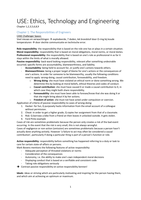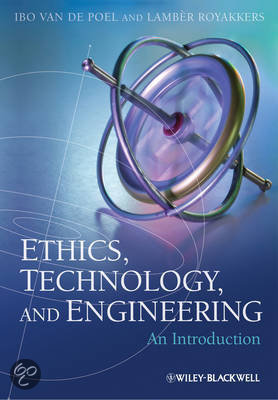USE: Ethics, Technology and Engineering
Chapter 1,2,3,5,6,8,9
Chapter 1: The Responsibilities of Engineers
CASE Challenger Space:
Veel nieuws en verwachtingen explodeerde, 7 doden, lek brandstof door O-ring bij koude
temperaturen door slechte communicatie en technische error.
Role responsibility: the responsibility that is based on the role one has or plays in a certain situation.
Moral responsibility: responsibility that is based on moral obligations, moral norms, or moral duties.
Professional responsibility: the responsibility that is based on one’s role as professional in as far it
stays within the limits of what is morally allowed.
Passive responsibility: back-ward looking responsibility, relevant after something undesirable
occurred; specific forms are accountability, blameworthiness, and liability.
- Accountability: being held to account for, or justify one’s actions towards others.
- Blameworthiness: being a proper target of blame for one’s actions or the consequences of
one’s actions. In order for someone to be blameworthy, usually the following conditions
need to apply: wrong-doing, causal contribution, foreseeability, and freedom.
o Wrong doing: she must have violated an ethical norm or done something wrong. We
determine this by looking at moral beliefs, ethical theories and codes of conduct.
o Causal contribution: she must have caused X or made a causal contribution to X, in
which case they might both share responsibility.
o Foreseeability: she must have been able to foresee/know that she was doing X or
that she might bring about X by her actions.
o Freedom of action: she must not have acted under compulsion or coercion.
Application of criteria of passive responsibility to cases of wrong-doing:
1. Hacker: for fun, Q purposely hacks information from the email account of a colleague
without permission.
2. Cheat: in order to get a higher grade, Q copies her assignment from that of a classmate.
3. Risk: Q borrows a bike from a friend an then leaves it unlocked outside. It gets stolen.
4. Ford Pinto example
Cases of risk are sometimes problematic because the person only creates a risk of the bad event
occurring. In the event that the risk is very small, this is not always wrongful.
Cases of negligence or non-action (omission) are sometimes problematic because a person hasn’t
actually done anything actively. However ‘a failure to act may often be considered a causal
contribution’, particularly if doing a particular thing is part of a person’s function or role.
Active responsibility: responsibility before something has happened referring to a duty or task to
care for certain state-of-affairs or persons.
Mark Bovens mentions the following features of active responsibility:
- Adequate perception of threated violations or norms
- Consideration of the consequences
- Autonomy, i.e. the ability to make one’s own independent moral decisions
- Displaying conduct that is based on a verifiable and consistent code
- Taking role obligations seriously
Contrast passive responsibility en active responsibility kennen!
Ideals: ideas or striving which are particularly motivating and inspiring for the person having them,
and which aim at achieving an optimum or maximum.
1
, Professional ideals: ideals that are closely allied to a profession or can only be aspired to by carrying
out the profession.
Technological enthusiasm: the ideal of wanting to develop new technological possibilities and taking
up technological challenges. The inherent danger of technological enthusiasm lies in the possible
negative effects of technology and the relevant social constraints being easily overlooked. (Google
Earth example, Wernher von Braun)
Effectiveness: the extent to which an established goal is achieved.
Efficiency: the ratio between the goal achieved and the effort required.
An example of an engineer who saw efficiency as an ideal was Frederick W. Taylor (Taylorism).
In 1911 Taylor published his The Principles of Scientific Management in which he explained the four
principles of scientific management:
- Replace the present rules of thumb for working methods with methods based on a scientific
study of the work process.
- Select, train and develop every worker in a scientific fashion instead of allowing workers to
do that themselves.
- Really work together with the workers so that the work can be completed according to the
developed scientific principles.
- Work and responsibility are virtually equally divided between management and workers. The
management does the work for which it is best equipped: applying scientific management
principles to plan the work; and the workers actually perform the tasks.
Taylor was really arguing that engineers were the only really capable managers.
A third ideal of engineers is that of contributing to or augmenting human welfare. ‘engineers shall
use their knowledge and skill for the enhancement of human welfare’. One of the most important
values that falls under the pursuit of human welfare among engineers is safety (Johan van Veen).
Technological enthusiasm and effectiveness and efficiency are ideals that are not necessarily morally
commendable, although they are also not always morally reprehensible; in both cases much depends
on the goals for which technology is used and the side-effects so created. Both ideals, moreover,
carry the danger of forgetting about the moral dimension of technology. On the other hand, the ideal
of human welfare confirms that the professional practice of engineers is not something that is
morally neutral and that engineers do more than merely develop neutral means for the goals of
others.
Three models of dealing with tension and the potential conflict between engineers and managers:
- Separatism: the notion that scientists and engineers should apply the technical inputs, but
appropriate management and political organs should make the value decisions.
o Illustrated by the tripartite model: a model that maintains that engineers can only be
held responsible for the design of products and not for wider social consequences or
concerns. In the tripartite model tree separate segments are distinguished: the
segment of politicians; the segment of engineers; and the segment of users.
o ‘hired gun’: someone who is willing to carry out any task or assignment from his
employer without moral scruples.
- Technocracy: government by experts. Problematic cause:
o It is not exactly clear what unique expertise engineers possess that permit them to
legitimately lay claim to the role of technocrats.
o Paternalism: the making of (moral) decisions for others on assumption that one
knows better what is god for them than those others themselves.
- Whistle-blowing: the disclosure of certain abuses in a company by an employee in which he
or she is employed, without the consent of his/her superiors, and in order to remedy these
abuses and/or to warn the public about these abuses.
o Guidelines for Whistle-Blowing:
2






